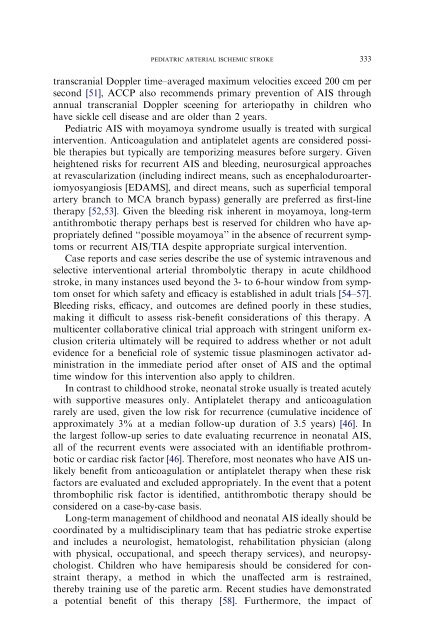Pediatric Clinics of North America - CIPERJ
Pediatric Clinics of North America - CIPERJ
Pediatric Clinics of North America - CIPERJ
Create successful ePaper yourself
Turn your PDF publications into a flip-book with our unique Google optimized e-Paper software.
PEDIATRIC ARTERIAL ISCHEMIC STROKE<br />
333<br />
transcranial Doppler time–averaged maximum velocities exceed 200 cm per<br />
second [51], ACCP also recommends primary prevention <strong>of</strong> AIS through<br />
annual transcranial Doppler sceening for arteriopathy in children who<br />
have sickle cell disease and are older than 2 years.<br />
<strong>Pediatric</strong> AIS with moyamoya syndrome usually is treated with surgical<br />
intervention. Anticoagulation and antiplatelet agents are considered possible<br />
therapies but typically are temporizing measures before surgery. Given<br />
heightened risks for recurrent AIS and bleeding, neurosurgical approaches<br />
at revascularization (including indirect means, such as encephaloduroarteriomyosyangiosis<br />
[EDAMS], and direct means, such as superficial temporal<br />
artery branch to MCA branch bypass) generally are preferred as first-line<br />
therapy [52,53]. Given the bleeding risk inherent in moyamoya, long-term<br />
antithrombotic therapy perhaps best is reserved for children who have appropriately<br />
defined ‘‘possible moyamoya’’ in the absence <strong>of</strong> recurrent symptoms<br />
or recurrent AIS/TIA despite appropriate surgical intervention.<br />
Case reports and case series describe the use <strong>of</strong> systemic intravenous and<br />
selective interventional arterial thrombolytic therapy in acute childhood<br />
stroke, in many instances used beyond the 3- to 6-hour window from symptom<br />
onset for which safety and efficacy is established in adult trials [54–57].<br />
Bleeding risks, efficacy, and outcomes are defined poorly in these studies,<br />
making it difficult to assess risk-benefit considerations <strong>of</strong> this therapy. A<br />
multicenter collaborative clinical trial approach with stringent uniform exclusion<br />
criteria ultimately will be required to address whether or not adult<br />
evidence for a beneficial role <strong>of</strong> systemic tissue plasminogen activator administration<br />
in the immediate period after onset <strong>of</strong> AIS and the optimal<br />
time window for this intervention also apply to children.<br />
In contrast to childhood stroke, neonatal stroke usually is treated acutely<br />
with supportive measures only. Antiplatelet therapy and anticoagulation<br />
rarely are used, given the low risk for recurrence (cumulative incidence <strong>of</strong><br />
approximately 3% at a median follow-up duration <strong>of</strong> 3.5 years) [46]. In<br />
the largest follow-up series to date evaluating recurrence in neonatal AIS,<br />
all <strong>of</strong> the recurrent events were associated with an identifiable prothrombotic<br />
or cardiac risk factor [46]. Therefore, most neonates who have AIS unlikely<br />
benefit from anticoagulation or antiplatelet therapy when these risk<br />
factors are evaluated and excluded appropriately. In the event that a potent<br />
thrombophilic risk factor is identified, antithrombotic therapy should be<br />
considered on a case-by-case basis.<br />
Long-term management <strong>of</strong> childhood and neonatal AIS ideally should be<br />
coordinated by a multidisciplinary team that has pediatric stroke expertise<br />
and includes a neurologist, hematologist, rehabilitation physician (along<br />
with physical, occupational, and speech therapy services), and neuropsychologist.<br />
Children who have hemiparesis should be considered for constraint<br />
therapy, a method in which the unaffected arm is restrained,<br />
thereby training use <strong>of</strong> the paretic arm. Recent studies have demonstrated<br />
a potential benefit <strong>of</strong> this therapy [58]. Furthermore, the impact <strong>of</strong>





